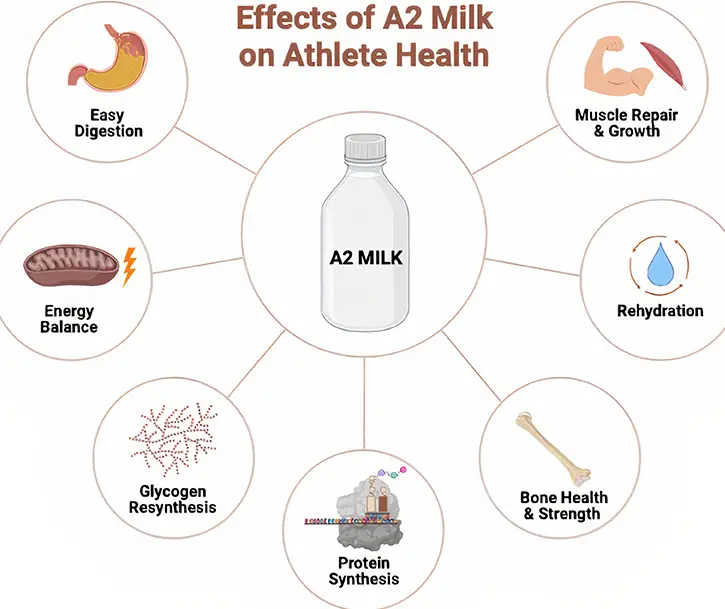Milk is a staple in many diets around the world, but not all milk is created equal. The rise of A2 milk and Lactaid has introduced new options for consumers, each catering to different dietary needs and health considerations. These products promise to enhance digestive comfort and provide alternatives for those with specific milk sensitivities.
A2 milk differs from regular cow’s milk in its protein structure, containing only the A2 type of beta-casein protein, which may be easier to digest for some people. Lactaid, on the other hand, is regular milk treated with lactase enzyme to break down lactose, making it suitable for lactose-intolerant individuals. This key distinction addresses the primary difference in their digestive health benefits and target consumer groups.
As consumer awareness grows, so does interest in how these milks compare not only in their digestive benefits but also in nutritional content, taste, cost, and environmental impact. With each offering unique advantages, choosing the right option depends on individual health needs and preferences.

What is A2 Milk?
Definition and Origins
A2 milk refers to milk that is rich in the A2 beta-casein protein, a type of protein naturally present in cow’s milk. This milk variety comes from specific breeds of cows that naturally produce milk with only the A2 type of beta-casein protein and not the A1 protein, which is more common in most dairy products. The distinction between A2 and A1 proteins lies in their genetic makeup, which affects how they are digested in the human body.
Originating from certain traditional breeds found in parts of Europe and Asia, such as the Jersey, Guernsey, and certain Indian cow breeds, A2 milk has gained popularity for its purported health benefits. The concept of A2 milk began gaining attention after research suggested that milk containing A1 proteins could be linked to digestive discomfort and other minor health issues in some individuals.
Production Process
The production of A2 milk involves a specific selection process:
- Breeding: Farmers selectively breed cows that naturally produce the A2 type of beta-casein.
- Testing: The milk from these cows is regularly tested to ensure it contains only the A2 protein.
- Processing: Once confirmed, the milk is processed in much the same way as regular milk, maintaining strict quality and safety standards to ensure purity and freshness.
What is Lactaid?
Definition and How It Is Produced
Lactaid is a brand of milk specially treated to remove lactose, the sugar found in milk that causes digestive issues for those with lactose intolerance. The process involves adding the enzyme lactase to regular cow’s milk. Lactase breaks down lactose into simpler sugars, glucose and galactose, which are easier to digest.
The production of Lactaid milk involves several key steps:
- Enzyme Addition: Lactase enzyme is added to regular milk.
- Incubation: The milk is then allowed to sit while the enzyme breaks down the lactose.
- Processing: After sufficient lactose breakdown, the milk is pasteurized and packaged.
Lactaid’s Primary Users
Lactaid is primarily aimed at individuals who are lactose intolerant and experience discomfort, such as bloating, gas, or diarrhea after consuming regular dairy products. This product allows them to enjoy milk without the adverse effects typically associated with lactose intolerance.
Nutritional Profiles
Nutritional Content of A2 Milk
The nutritional profile of A2 milk is comparable to that of conventional cow’s milk, providing a good source of calcium, protein, and vitamin D. However, the key difference is its protein content, which may be easier on the stomach for some people due to the absence of A1 beta-casein.
Nutritional Content of Lactaid
Lactaid milk offers the same nutritional benefits as regular milk, including high levels of calcium, protein, and vitamin D. The primary difference is its lactose content, which is minimal or nonexistent, making it digestible for those with lactose intolerance.
Benefits of A2 Milk
Digestive Benefits
A2 milk may provide relief for individuals who experience discomfort from regular cow’s milk but are not necessarily lactose intolerant. The absence of A1 beta-casein in A2 milk might reduce symptoms related to milk sensitivity such as bloating and abdominal pain.
Potential Health Advantages
Beyond digestive health, A2 milk is studied for potential benefits related to inflammation and cardiovascular health, though more research is needed to conclusively prove these benefits. Nonetheless, A2 milk remains a preferred choice for those sensitive to conventional dairy proteins.
Benefits of Lactaid
Lactose Intolerance Management
The primary benefit of Lactaid is its role in managing lactose intolerance symptoms. By removing lactose, Lactaid allows individuals to enjoy milk and dairy products without discomfort or digestive issues.
Additional Health Benefits
Besides managing lactose intolerance, Lactaid provides all the nutritional benefits of regular milk, essential for bone health, muscle function, and overall well-being, without the digestive distress associated with lactose.

Taste and Texture
Description of A2 Milk Taste
A2 milk is often described as richer and creamier than regular milk. Consumers typically note a subtle difference, with some describing the flavor as slightly sweeter and smoother. This taste profile makes A2 milk a preferred choice for those who enjoy a full-bodied flavor in their milk.
Description of Lactaid Taste
Lactaid, while retaining the essential characteristics of traditional cow’s milk, can sometimes have a slightly sweeter taste due to the breakdown of lactose into glucose and galactose. This sweetness does not alter the milk’s natural flavor significantly but may be noticeable to sensitive palates.
Texture Comparison
In terms of texture, A2 milk does not differ markedly from standard cow’s milk; it retains the same fluid consistency. Lactaid, however, may appear slightly thinner than regular milk to some users, though this does not affect its usability in recipes or when consumed directly.
Cost Analysis
Price Comparison
Generally, A2 milk is priced higher than regular cow’s milk due to the selective breeding of cows and testing processes required to ensure the milk only contains A2 protein. On the other hand, Lactaid also tends to cost more than ordinary milk due to the additional processing needed to add lactase and remove lactose.
Availability in Markets
A2 milk and Lactaid have become more widely available due to rising consumer demand. A2 milk can be found in many health food stores, larger supermarkets, and specialty dairy outlets. Lactaid is even more widespread, available in nearly all grocery stores, often positioned alongside other lactose-free dairy products.
Consumer Preferences
Demographics Preferring A2 Milk
A2 milk is especially popular among health-conscious consumers who are aware of their dietary sensitivities but do not have lactose intolerance. It appeals to families with children, individuals who seek to reduce gastrointestinal discomfort, and those interested in natural food products.
Demographics Preferring Lactaid
Lactaid is predominantly used by those who are lactose intolerant. It is a go-to solution for a wide age range, from young children to elderly adults, who want to enjoy dairy without adverse reactions. Health practitioners often recommend Lactaid to patients who report symptoms of lactose intolerance.
Environmental Impact
Farming Practices for A2 Milk
The production of A2 milk focuses on sustainable and ethical farming practices. This includes:
- Selective Breeding: Ensuring that only cows producing A2 protein are bred.
- Grazing Management: Implementing rotational grazing that enhances soil health and biodiversity.
- Animal Welfare: Maintaining high standards of care and welfare for the dairy cows.
These practices contribute to a more sustainable dairy industry, although the emphasis on specific A2-producing breeds may limit genetic diversity.
Production Impact of Lactaid
The production of Lactaid involves additional processing steps, which may increase energy use and production costs. However, Lactaid manufacturers aim to minimize the environmental impact by:
- Efficient Processing: Using modern technologies to add lactase efficiently.
- Recycling Programs: Implementing packaging recycling programs to reduce waste.
- Energy Management: Employing energy-efficient practices throughout production to decrease the carbon footprint.
Frequently Asked Questions
What is A2 Milk?
A2 milk refers to milk that contains predominantly the A2 type of beta-casein protein. It is derived from specific breeds of cows that naturally produce this form of protein, which is said to be easier on digestion for some people.
What is Lactaid Milk?
Lactaid milk is regular cow’s milk that has been treated with the enzyme lactase to break down lactose, a sugar which can cause digestive discomfort for lactose-intolerant individuals. This process makes it digestible and symptom-free for them.
How does A2 milk benefit health?
A2 milk may reduce some symptoms associated with milk intolerance not related to lactose, such as bloating and abdominal discomfort, due to the absence of A1 beta-casein, which some people find harder to digest.
Can lactose-intolerant people drink A2 milk?
No, lactose-intolerant individuals cannot drink A2 milk unless it is also lactose-free. A2 milk contains lactose, just like regular cow’s milk, and will cause discomfort to those with lactose intolerance.
Is Lactaid milk organic?
Lactaid milk can be organic if it comes from organic dairy farms. However, the Lactaid brand itself offers both organic and non-organic products, catering to different consumer preferences.
Does A2 milk taste different?
A2 milk is reported to have a creamier and richer taste compared to regular cow’s milk, which some consumers might prefer. The taste difference is subtle but noticeable to discerning palates.
Conclusion
Deciding between A2 milk and Lactaid largely depends on one’s dietary needs and personal health conditions. A2 milk offers a solution for those who have issues with certain milk proteins, while Lactaid is tailored for those who cannot tolerate lactose. Both options provide a way for people to enjoy the benefits of milk while avoiding the discomfort traditionally associated with dairy consumption.
Understanding these options allows consumers to make informed decisions about their health and dietary needs. As the market for specialized dairy products grows, the availability of clear and concise information will be key in guiding consumer choices effectively.
